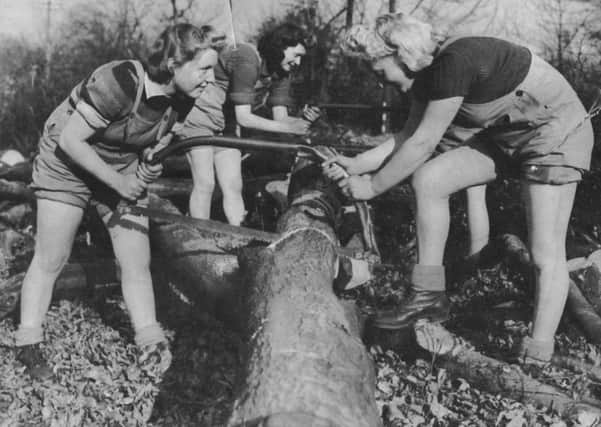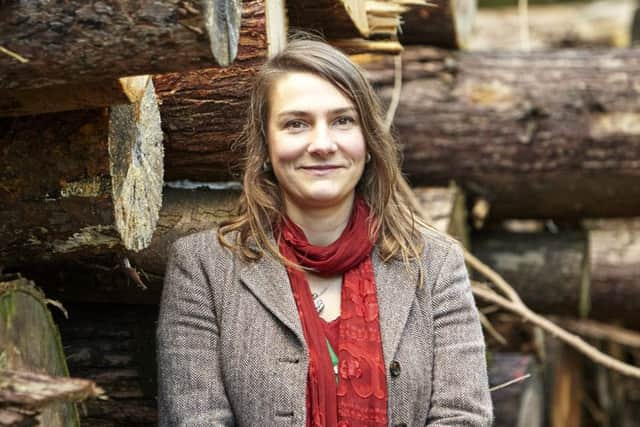The role of the Women’s Timber Corps during the Second World War is often overlooked - now a new book examines the role they played


They weren’t fighting on the frontline, or working in hospitals, nor were they part of the team of codebreakers housed in places like Bletchley Park, though their endeavours were no less important to the war effort.
They were female forestry workers, or ‘Lumberjills’ as they became affectionately known. They replaced men who had gone off to fight, carrying out the arduous task of felling, snedding, saw milling and loading lorries and trains.
Advertisement
Hide AdAdvertisement
Hide AdDespite its importance, the work of the Women’s Timber Corps (WTC) has largely been overlooked which is one of the reasons why Joanna Foat decided to write about their exploits in her book, Lumberjills – Britain’s Forgotten Army.


It was while she was working at the Forestry Commission that Foat started looking at the role of women in forestry and was surprised to learn that they had been involved in the industry as far back as the First and Second World Wars.
“When I told people about this no one knew seemed to know about them, even female foresters I talked to.”
Following the outbreak of war in 1939, Foat says the government was reluctant to have an all-female service timber team, so they recruited people via the Women’s Land Army.
Advertisement
Hide AdAdvertisement
Hide AdMany women were used in farming and agriculture to help with food production and some women were selected for “lighter” timber duties – such as planting trees and working in nurseries. But they were used to carry out a wide range of duties.
“Some were chosen because they were good at mathematics to help work out the quantity of timber needed for production, and this was the justification for allowing women to work in this industry to begin with.”
In other parts of the country, though, women were recruited to help with felling and haulage and saw mill work.
It wasn’t until they “proved themselves” that a Women’s Timber Corps was finally set up in 1942. As Foat points out, they carried out crucial work.
Advertisement
Hide AdAdvertisement
Hide Ad“Timber during wartime was needed for everything from shipbuilding to construction. Half the timber was also needed down the mines to keep them operating and supporting all the wartime industries.
“These women were doing very different jobs such as felling the timber, loading the lorries and driving the tractors. Others were doing acquisition work which meant negotiating with landowners to purchase vast swathes of forest.”
They came from all kinds of backgrounds – some had been mill or factory workers, while others were everything from hairdressers to university graduates.
Foat interviewed several women who had been lumberjills for her book, including some from Yorkshire. Among them was Mary Broadhead from Barnsley, who has since passed away.
Advertisement
Hide AdAdvertisement
Hide Ad“There was this policy which meant they didn’t want to send women to work near their home so she went to work in a forest in Kent. She lost a thumb working in a sawmill and had to wait two hours to get a lorry to transport her to hospital. There had been an air raid and she had to wait even longer to get permission from her parents to have a general anaesthetic.”
Mary also volunteered to be a Red Cross ambulance driver, helping ferry casualties to hospital. “She was a tough and incredible lady.”
The late Edna Holland was another lumberjill. A spinner by trade, she trained in Wetherby and worked in felling and haulage using horses and driving tractors at Dalby Forest, Boltby and other forests on the North York Moors.
“She had really interesting experiences. She told me they had to live where the forests were and she said that quite often the locals didn’t like the look of them when they first arrived, because it was unusual back then to see strong women who probably looked a bit wild with their big boots and their trousers.”
Advertisement
Hide AdAdvertisement
Hide AdIn some cases there was open hostility towards the women. “Some people asked them not to walk past their house because they felt they brought the tone of the area down so they had to take a different route to work.”
The press, too, initially questioned their value. A cartoon, published in our sister newspaper the Yorkshire Evening Post, of a woman standing next to a bandaged tree, shows her talking to a man saying: “I suddenly found I’d started cutting down the wrong tree.”
In some instances there was disbelief that women were actually working in what was seen as a male dominated industry. “There were so many stories of women having to explain to people what they did.”
However, the lumberjills eventually won round both the public and the press. “Attitudes started to change as people got used to the idea of women doing these kind of jobs, and you can see this change over the course of the war.
Advertisement
Hide AdAdvertisement
Hide Ad“There was a complete transformation from the negative attitudes at the start of the war, compared with the end of the war when they were praising the girls for the amazing job they were doing.”
Foat says there was a significant transformation in Britain’s timber fortunes from 1939 compared with the end of the war. “The UK was the largest importer of timber in the world and that’s why it was so important to scale up. The collieries were absolutely desperate because they only had seven months supply of pit props so there was real anxiety about whether we’d have enough home grown wood, because during the First World War we’d taken up half the country’s timber.”
During the Second World War, though, more wood was produced in Britain than ever before in history. “Women worked alongside thousands of German and Italian POWs, as well as British civil prisoners, conscientious objectors and older forestry workers who were too old to be called up to fight.”
So why was their contribution overlooked for so long? “There’s something about forests being out of the way so it becomes a case of ‘out of sight, out of mind,” says Foat.
Advertisement
Hide AdAdvertisement
Hide Ad“The women weren’t recognised at the end of the war and they weren’t allowed to take part in Remembrance Day parades because they weren’t part of the fighting forces.”
Foat says their records were destroyed and for many years they all but slipped off the pages of Britain’s war story. Yet their exploits were there for all to see. At teir peak the number of women in the timber corps totalled as many as 18,000, and together they produced 18 million tonnes of wood and supplied 60 per cent of our timber needs during the war.
“The man in charge of timber said without the Lumberjills we would not have met our targets, so they played a hugely significant role.”
For Foat, these ordinary women were pioneers in the ongoing battle for gender equality and believes they deserve greater recognition. “They are part of the story of women being treated equal to men. It’s incredible that in their day they really challenged those stereotypes about what women can be. That story is still being told today with even more vigour and this is part of that history.”
Lumberjills – Britain’s Forgotten Army, published by The History Press, is out now priced £14.99.